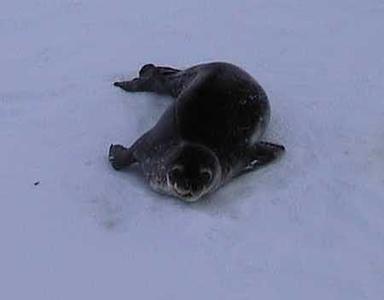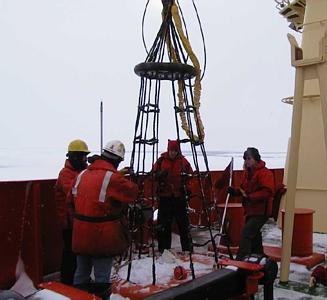
|
|
10 March, 2000
The Seal People in Their Tower
72 15 s, 114 30 w
-7 C (19 F), 15 knot (17 mph) wind out of the southwest
Barometer 972 MB and dropping, steady moderate snow
Ship heading 320 @ 5 knots (6 mph)
100% ice pack coverage
Depth 476 m (1562 feet)
Once again I'm on the bridge in the early morning darkness,
watching the snow in the spotlights, not the stars in the sky. The
Nathaniel B. Palmer is in transit to Thwaites and Pine Island glaciers, but
it is not a direct route. We're in heavy ice, occasionally backing and
ramming. The crew picks the best possible path, which sometimes involves
going around very large flows, or retracing our path. Occasionally the ice
halts the ship altogether. When this happens, the slowing down and stopping
occurs so gradually that it is hard to tell exactly when the ship has
completely stopped. Then, just as gradually and smoothly, it starts to back
up. Once in a while, the propellers hit a large chunk of ice floe. Then you
hear and feel a distinct shudder.
When the ship is in heavy ice floes like this, it almost seems as
if I could run along beside it, or at least ski. There are very few cracks
I could not jump across. I'd have to stay away from the ship, though,
because it breaks and overturns floes as it goes.
Answer to yesterday's question: Why are there fewer than 30
planktonic foram species, while there are thousands of benthic types?
Planktonic animals float and move around with the water. The populations
mix and a few dominant types survive. Benthic forams probably cannot travel
more than a few centimeters in their lifetimes, so populations become
localized. Also, the environment of benthic forams, nutrients and oxygen,
for example, vary widely over short distances. Planktonic forams live in an
environment that is usually the same for hundreds of kilometers in any
direction, and several hundred meters vertically. Since the water they live
in is always mixing and moving, they may move many kilometers in their
lifetimes. They are adapted to a huge water mass, not a few square
centimeters of bottom.
Since we are in transit, and a slow transit at that due to ice
conditions, I have a little bit more free time on my hands. I took the
opportunity today to go up to the ship's ice tower, and talk with the seal
people.
The ice tower observation post is a little room three stories
above the bridge. It is used sometimes by the crew to find ways to get the
Nathaniel B. Palmer through dense pack ice. To get to it, you climb three
ladders and go through a hatch. There is enough space for three or four
people, and big windows all around. There is a little electric heater, and
a couple of comfortable chairs. There are window ledges for binoculars,
and to lean against if the ship is rocking. There is even a door and a
little catwalk around the outside of the tower, if you need fresh air or
want to take a picture. Best of all, there is some of the wildest scenery
on planet Earth all around you, from horizon to horizon. One of today's
pictures, the iceberg with the peak, was taken from the catwalk. The ice
tower is definitely the top of the bottom of the world.
The seal people, Dr. Suzanne Hill and Dr. Brad Scotton, spend
hours each day up in the ice tower watching for and counting seals, whales
and penguins.
When she is not in the ice tower, Sue Hill spends most of her time
in Redmond Washington. There she is part owner of a company and full time
mother of three children, two boys eight and twelve, and a girl ten. She
has been coming to Antarctica since 1982, when she studied Weddell seal
parenting at McMurdo station, for her doctorate degree. She met her future
husband there, and she's been back to Antarctica many times since. She says
she comes because she likes to study seals, she likes Antarctica, and she
wants to give her children something to aspire to.
She says, "This is beautiful. It's much more fun than hanging
around the mall. You don't have to play games. You're respected for what
you can do. There are lots of women who are respected scientists."
Her company makes several different products. One of these is a small,
light radio transmitter that is glued to a seal's back, directly to the
hair. Seals are big animals, and the little transmitter doesn't seem to
interfere with their activities. When they shed their hair (molt) the
transmitter falls off. Most amazing to me is that the tiny transmitters,
with about the power of a flashlight bulb, transmit directly to passing
weather satellites, and may do so for up to a year before the battery runs
out, or the seal molts and sheds the device. The information sent up to
orbit includes data like the depth of dives and time spent diving, and the
temperature of the seal's surroundings. On a recent cruise of the Nathaniel
B. Palmer, thirty of Sue's transmitters were glued to seals. They are now
sending back data.
When Brad Scotton is not in Antarctica, he works at the other end of the
world, as a wildlife biologist for the State of Alaska's Department of Fish
and Game. Brad was an undergraduate there. He drove to Alaska four days
after he got his high school diploma. He says he would have gone earlier,
but felt obligated to spend some time after graduation with his family. He
figured four days was enough. In Alaska he studies many different animals,
including salmon, moose, caribou, bison, wolves and Dall sheep.
He first came to Antarctica in 1991, as an undergraduate in college. He
lived in "fish huts" on the Ross Sea ice, studying Weddell seals. He says
the fish huts were just like ice fishing shacks, enclosed sheds with a trap
door in the bottom, which could be dragged over a hole in the ice for seal
or fish research. The National Science Foundation paid his way through
their R.E.U. (Research Experience for Undergraduates) program, which is
still active. It is one of several ways undergraduate college students can
get to Antarctica. Like Sue, Brad has been back to Antarctica several times.
They are not here just for the fun of watching seals, penguins and whales.
Suzanne and Brad are doing their research as part of a program called the
APIS project. APIS stands for Antarctica Pack Ice Seals. It is a five year
effort by several different countries to study Weddell, Crabeater, Ross and
Leopard seals. Some scientists think that the populations of these seals
have increased at the same time that the number of whales decreased,
because both compete for the same krill food supply. APIS hopes to find out
among other things how many of these seals exist, where they live, and if
they stay in one area or move around the continent's shores. APIS wants to
learn more about the relatively rare Ross seals, about which little is known.
When they spot seals, whales or penguins Brad and Sue record the species,
location, time and date, and angle below the horizon. They also note
information about the type and size of ice floe the animals are on or near.
They look for scars on seals, especially Crabeater seals.
A great number of Crabeaters have parallel scars about ten centimeters
(four inches) apart. Sometimes these scars extend most of the way around
their bodies. The explorer Shackleton thought that the scars were from
killer whale (Orca) attacks, but they match more accurately the spacing of
Leopard seal teeth. Whatever the predator, a lot of Crabeater seals must
come very near death and survive.
While we talk, a Minke whale surfaces in a nearby lead, blows spray, rolls
and plays, and dives. Brad records the event on his clipboard. An Emperor
and two Adelie penguins also get noted.
The APIS project is interested in penguins, both for their own sake, and
because these birds occupy the same part of the food web as seals. Both are
krill eaters, and both have increased in numbers since whale numbers
decreased. Ice information is important in the penguin research.
Researchers want to know, for example if the comic little Adelie penguins
purposefully choose, for example, large floes or floes with ice ridges. The
Adelies may use the ridges to escape Leopard seals, or to shade themselves
from the wind.
If Sue and Brad spot a group of seals, they decide if the floe looks safe
for people to walk on. If it does, they may ask the ship to stop, so that
they can examine the seals closely, and get a small DNA sample from each.
They have promised to let me accompany them next time they go out on the
ice. I've been watching seals from the ship, and I'd really like a chance
to see some close up.

A Weddell Seal pup born late in 1999.

Bergs come in all shapes.This one is about 30 meters (100 feet) high. It would be fun to climb the peak, or camp on the flat part for a day or two, but after a while I'd miss the ship.

The "seal people" and helpers get ready to go out on the ice floes. From left to right: Dr. Brad Scotten, Jesse Doren (back to camera), Drew Lucas, and Dr. Susan Hill. The little orange bag has a throwing rope, in case someone goes through the ice.
Contact the TEA in the field at
.
If you cannot connect through your browser, copy the
TEA's e-mail address in the "To:" line of
your favorite e-mail package.
|
